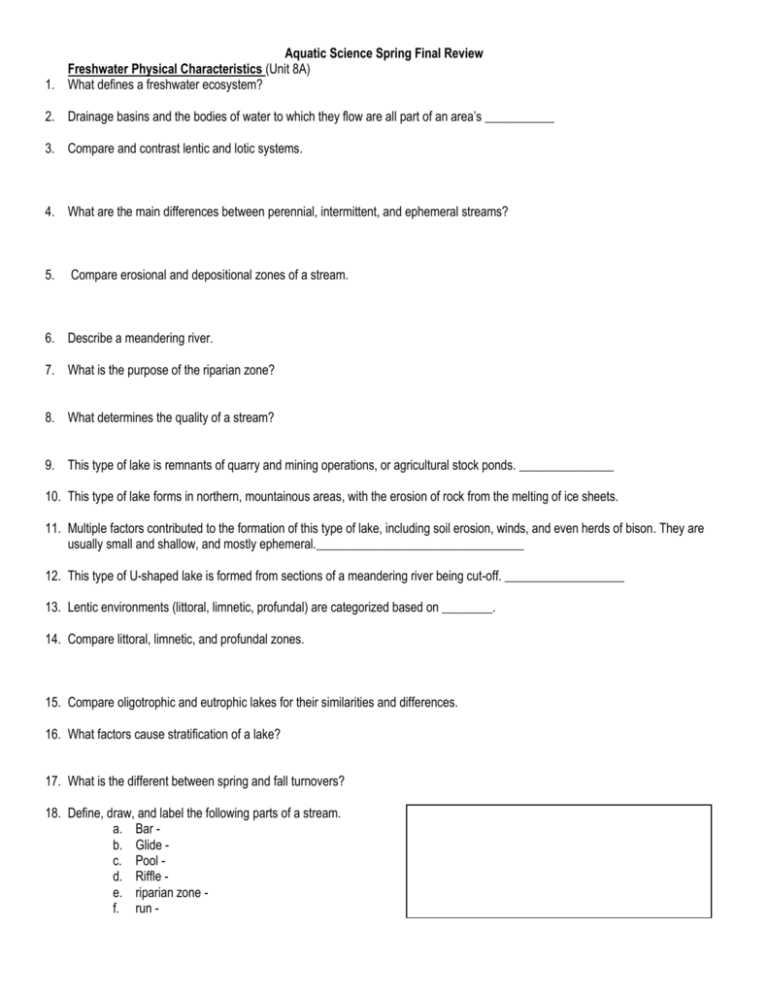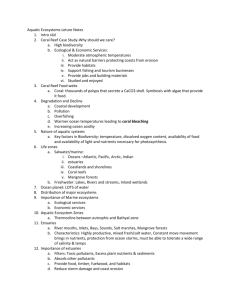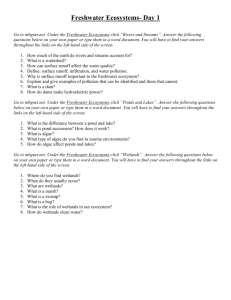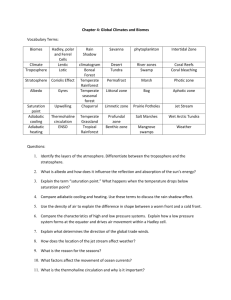Unit 8A Notes: Physical Characteristics of Freshwater Habitats
advertisement

Aquatic Science Spring Final Review Freshwater Physical Characteristics (Unit 8A) 1. What defines a freshwater ecosystem? 2. Drainage basins and the bodies of water to which they flow are all part of an area’s ___________ 3. Compare and contrast lentic and lotic systems. 4. What are the main differences between perennial, intermittent, and ephemeral streams? 5. Compare erosional and depositional zones of a stream. 6. Describe a meandering river. 7. What is the purpose of the riparian zone? 8. What determines the quality of a stream? 9. This type of lake is remnants of quarry and mining operations, or agricultural stock ponds. _______________ 10. This type of lake forms in northern, mountainous areas, with the erosion of rock from the melting of ice sheets. 11. Multiple factors contributed to the formation of this type of lake, including soil erosion, winds, and even herds of bison. They are usually small and shallow, and mostly ephemeral._________________________________ 12. This type of U-shaped lake is formed from sections of a meandering river being cut-off. ___________________ 13. Lentic environments (littoral, limnetic, profundal) are categorized based on ________. 14. Compare littoral, limnetic, and profundal zones. 15. Compare oligotrophic and eutrophic lakes for their similarities and differences. 16. What factors cause stratification of a lake? 17. What is the different between spring and fall turnovers? 18. Define, draw, and label the following parts of a stream. a. Bar b. Glide c. Pool d. Riffle e. riparian zone f. run - Freshwater Ecology (Unit 8B) 19. What is found in an ecosystem? 20. What are some examples of abiotic and biotic factors? 21. Describe the characteristic & give examples of : a. Parasitism b. Commemsnsalism c. Mutualism d. Predation e. Producer-consumer feeding relationship 22. How does energy flow through an ecosystem? 23. What is the difference/examples of a primary, secondary, Tertiary Consumers & decomposers? 24. How much energy is transferred from one trophic level to the next? What happens to the rest of the energy? (Be able to do math!!!) Freshwater Organisms (Unit 8C) 25. What are the General Characteristics of freshwater macroinvertebrates? 26. How are macroinvertebrates grouped 27. Why are macroinvertebrates an important part of an ecosystem? 28. Know the General characteristics of freshwater fish. 29. How are fish grouped? 30. How do the shape and the position of the fins affect the fish’s swimming and maneuvering abilities? Wetlands 31. What are the characteristics of all wetlands? 32. Describe some plant adaptations for freshwater and coastal wetlands. 33. List 9 reasons that wetlands are important: 1. 4. 2. 5. 3. 6. 7. 8. 9. 34. What is a freshwater wetland and how are they formed? 35. Compare a marsh, swamp and bog in terms of structure, characteristics, and what makes them different. 36. What is coastal wetland and how are they formed? 37. What is an estuary and why are they important? 38. How have humans negatively impacted estuaries? 39. What is a salt marsh and why are they important? 40. How are deltas formed? 41. Describe how salt marshes are formed 42. What characteristics control the type of plants that grow in a salt marsh? 43. Describe the characteristics of a lagoon. Coasts 44. Describe a coast. 45. What is responsible for causing a global change in sea level? 46. Describe the glacial cycle. 47. Describe a change in an ocean basin 48. When will an area of land rise? 49. Compare/contrast a drowned coast and an emergent coast. 50. What processes help shape coastal landscapes? 51. Primary coasts are shaped by __________, whereas secondary coasts are shaped by _______. 52. List examples of a primary coast and a secondary coast. 53. How do waves cause erosion of rocky cliffs? 54. Describe and give an example of a marine-deposition coast. 55. How are barrier islands formed? 56. What are the two main threats to land areas posed by the sea? 57. What are examples of “hard” engineering techniques? 58. What are examples of a “soft” engineering technique. Shores 59. What describes a beach? 60. List facts that are true about materials that make up beaches. 61. Describe the formation and purpose of a sand dune. 62. Compare and contract a continental island and a volcanic island. 63. Why do islands support more endemic species than mainland areas? 64. Arthropods are classified together because they have _______________________________________________________ 65. What are some examples of aquatic arthropods? 66. Mollusks are all classified together because they have67. What are some examples of aquatic mollusks? 68. Describe the main characteristics that tell the sea turtles below apart from each other. a. Kemp Riddley b. Green c. Leatherback d. Loggerhead e. Hawksbill Seagrass, Kelp, and Coral 69. What are the differences between seagrasses and algae? 70. What are seagrass and kelp communities used for? Name some animals found there. 71. Describe the characteristics of: Fringing reefs Barrier reefs Atolls Bank reefs Patch reefs 72. What is the animal that makes up coral called? 73. What are the main characteristics of coral? 74. What are some human impacts on coral reefs? Natural impacts? 75. What is coral bleaching, what causes it? 76. Phylum porifera means: 77. Describe general characteristics of sponges. 78. How do sponges eat? 79. How do sponges reproduce? 80. How do sponges protect themselves? 81. Phylum Cnidarians means: 82. Describe general characteristics of cnidarians and list the 4 groups. 83. What are some examples and characteristics of the following cnidarians? a. Box Jelly b. Lion’s Main Jelly c. Moon Jelly d. Portuguese Man-of-War e. Purple Jelly f. Upside Down Jelly 84. How do jellyfish reproduce? What is it called? 85. Phylum Echinoderm means 86. What are the 5 classes of Echinoderms and what animals are found in each class? 87. Describe characteristics of an echinoderm, and list examples. 88. Describe how echinoderms feed. 89. List some ways that sponges, cnidarians, and echinoderms defend themselves.








